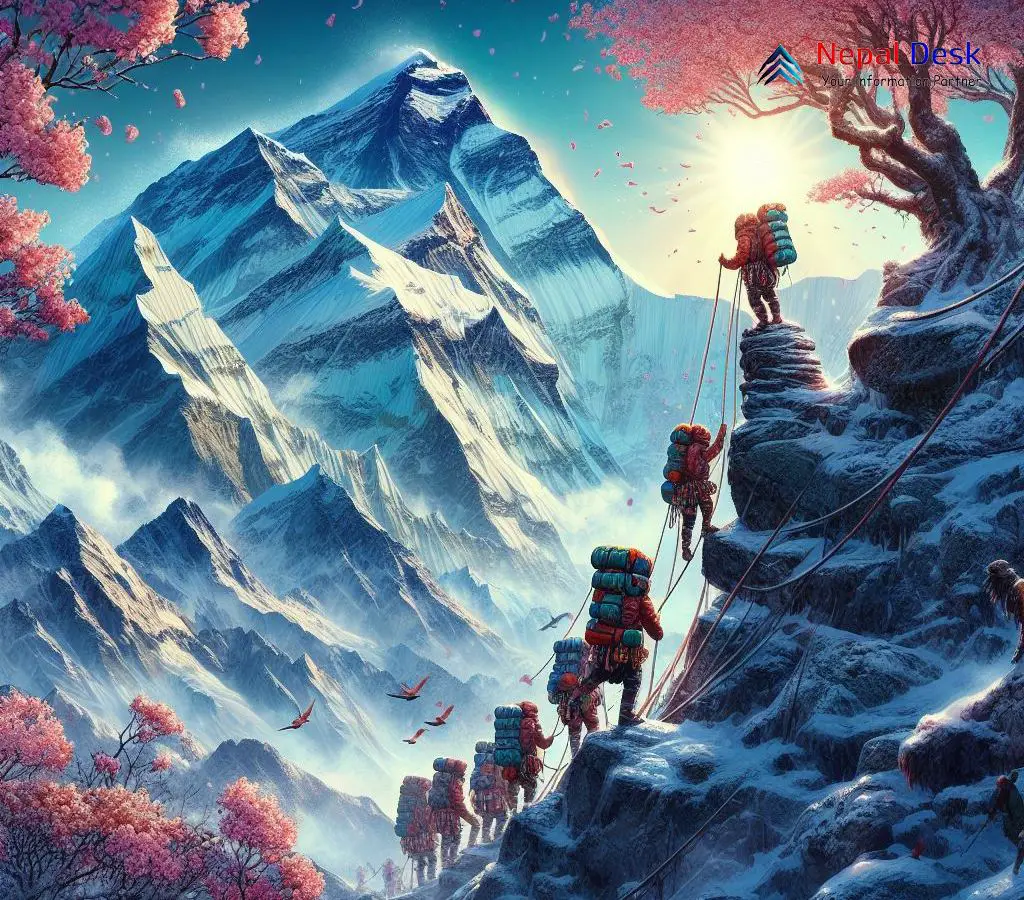Mt Everest Spring Climbing Season Begins: Insights and Preparations
Published Date

Published Date
Explore the commencement of the spring season on Mount Everest, including the distribution of climbing permits and an overview of the seasons.
⏱ 4 min read
The spring mountaineering season kicks off with the Department of Tourism, functioning under the Ministry of Culture, Tourism and Civil Aviation, beginning to distribute mountaineering permits. Kicking off this season's expeditions, an eight-member international squad from Himalayan Guides has been granted permission to ascend Mount Everest, marking the inaugural permit issuance for this period. Rakesh Gurung, the DoT's Director, extended his hearty wishes for success to the team while handing over the permit and encouraged the leader to promote Nepal as a premier tourist destination.
Iswari Paudel, at the helm of Himalayan Guides as Managing Director, proudly announced that their team—led by the illustrious mountaineer Chhuldim Ang Dorjee Sherpa—is gearing up for the Everest challenge after receiving the first permit of the season from the DoT. The team is a melting pot of adventurers hailing from nations such as the United States, Australia, the United Kingdom, and Ireland. Team leader Sherpa, a native of Pangboche, prepares for his impressive 23rd ascent.
Meanwhile, Tshiring Sherpa, head of the Sagarmatha Pollution Control Committee, shared updates on logistical preparations for upcoming climbs. He disclosed that a specialized team known as icefall doctors will carve out a route to Camp II starting from the Base Camp and are expected to reach Camp I by early April. They are currently busy setting up ropes and ladders through hazardous sections of the mountain.
The tourism department anticipates a surge in climbing activity on Mount Everest this year, predicting a higher number of permits being issued than ever before. This situation stands to exacerbate crowding and potential safety risks during summit attempts. In 2023 alone—a year marked by an all-time high with 478 permits issued exclusively by Nepal due to closures on Tibet's Northern route—climbing fatalities peaked with 19 individuals either missing or confirmed deceased.
According to Rakesh Gurung who leads Adventure Tourism and Mountaineering at the Department, thirty-three climbers have so far secured permits to tackle four distinct peaks this ongoing season. These include access to Mt Ama Dablam for three climbers, another five aiming for Himlung Peak one individual headed for Jugal Mountain, and an ambitious twenty-four targeting Mt Annapurna. Further details emerging from Gurung highlight arrangements made by the department facilitating online booking services for those eager to climb Mount Everest starting tomorrow.
Seasons of Everest: An Overview
Nestled 28 degrees north of the equator, Mount Everest endures the quintessential seasonal fluctuations characteristic of the northern hemisphere. This monolithic peak perches at the periphery of the Indian Monsoon's domain, with moist air and cloud cover enveloping the region from June through September. While December and January usher in a bitter chill, the prime windows for trekking around Everest are situated between these frosty months—in the milder intervals of March to May and October to November.
1. Winter Weather: From November to February, Everest’s winter clime is at the mercy of the jet stream shifting southwards. Whipping winds, a significant drop in temperatures, and sporadic episodes of substantial snowfall mark this period. Yet, winter presents a unique charm for trekking enthusiasts; those willing to brave the chill will find solace in thinner crowds. Days can be pleasantly sunny and crisp, despite nocturnal temperatures plummeting below freezing.
2. Spring: A Prelude to Monsoon: The stretch from March until the monsoon's dawn is often considered prime trekking season at Everest. During this time, rainfall is rare, and daytime temperatures invite warmth, tempting many adventurers to hit the trails in just t-shirts amidst an energetic atmosphere.
3. Monsoon Season: The summer months—June through September—are dominated by the Indian Monsoon's presence. This brings along frequent rains and overcast skies. Solitude seekers may appreciate this time; however, with clouds masking the majestic peaks more often than not, it's far from ideal for those hoping to feast their eyes on Everest.
4. Autumn: The Post-Monsoon Clarity: Following the monsoon's retreat through December, autumn claims its rightful place as another excellent season for trekking. Weather patterns stabilize during this period, revealing clear skies and propitious temperatures that beckon outdoor enthusiasts back onto Everest's trails.
Due to the ensuing monsoon season, travel advisors typically caution against planning expeditions between June and September. The persistent gloom and precipitation during these months shroud Everest’s summits from view, often disappointing visitors who may hardly catch a glimpse of its grandeur.
